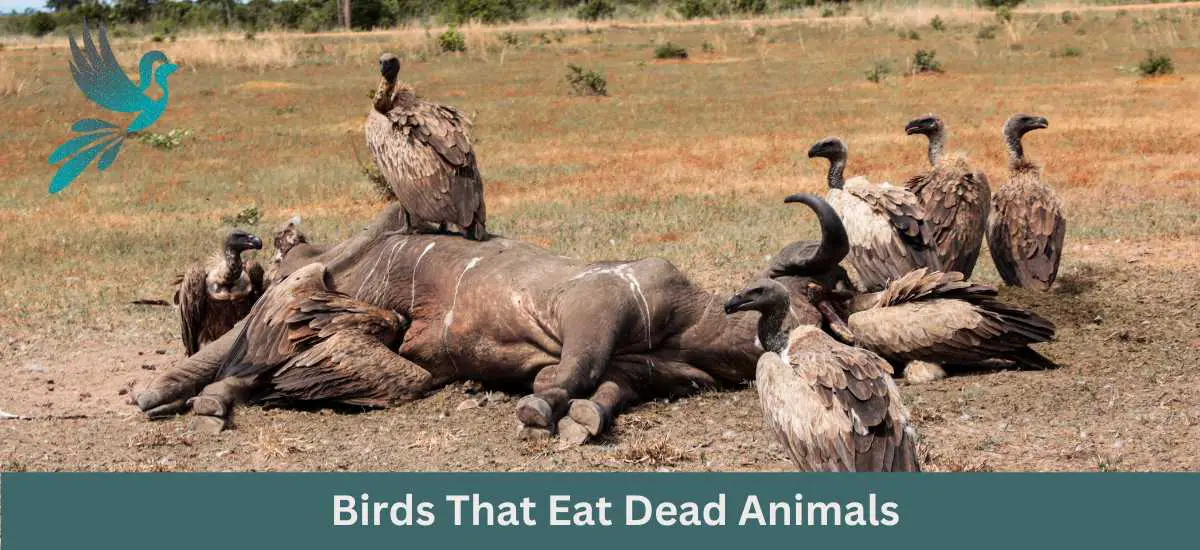Birds are usually associated with peaceful and graceful creatures, but some bird species have a dark and macabre side to their diet.
In this article, we’ll uncover the 35 birds that feed on dead animals, from well-known species such as vultures to backyard birds that may surprise you.
In North America, common backyard birds that eat carrion include the Turkey Vulture, the Black Vulture, the Common Raven, and the American Crow. Some species of Hawks and Owls, such as the Red-tailed Hawk and the Great Horned Owl, may also eat carrion as a supplement to their usual diet of live prey.
List of birds that eat dead animals:
| Common Name | Latin Name | Regions |
|---|---|---|
| Black Vulture | Coragyps atratus | Americas |
| Turkey Vulture | Cathartes aura | Americas |
| California Condor | Gymnogyps californianus | Western North America |
| Andean Condor | Vultur gryphus | South America |
| King Vulture | Sarcoramphus papa | Central and South America |
| Egyptian Vulture | Neophron percnopterus | Africa and Eurasia |
| Griffon Vulture | Gyps fulvus | Africa, Europe, and Asia |
| Hooded Vulture | Necrosyrtes monachus | Africa |
| Eurasian Griffon Vulture | Gyps fulvus | Europe and Asia |
| Lappet-faced Vulture | Torgos tracheliotos | Africa and Eurasia |
| Bearded Vulture | Gypaetus barbatus | Europe, Africa, and Asia |
| American Black Vulture | Coragyps atratus | Americas |
| Lesser Yellow-headed Vulture | Cathartes burrovianus | Central and South America |
| Cinereous Vulture | Aegypius monachus | Europe and Asia |
| New World Vulture | Cathartidae family | Americas |
| Old World Vulture | Aegypiidae family | Africa, Europe, and Asia |
| American Raven | Corvus corax | Americas |
| Common Raven | Corvus corax | Holarctic |
| Chihuahuan Raven | Corvus cryptoleucus | Southwestern United States and Mexico |
| Fish Raven | Corvus ossifragus | Alaska |
| Carrion Crow | Corvus corone | Europe, Asia, and North Africa |
| American Crow | Corvus brachyrhynchos | Americas |
| Northwestern Crow | Corvus caurinus | Pacific Northwest |
| Northern Raven | Corvus corax | Holarctic |
| Magpie | Pica pica | Holarctic |
| Black-billed Magpie | Pica hudsonia | Western North America |
| Yellow-billed Magpie | Pica nuttalli | Western North America |
| Eurasian Jay | Garrulus glandarius | Europe and Asia |
| Blue Jay | Cyanocitta cristata | Eastern North America |
| Steller’s Jay | Cyanocitta stelleri | Western North America |
| Gray Jay | Perisoreus canadensis | Canada and Alaska |
| Clark’s Nutcracker | Nucifraga columbiana | Western North America |
| Scrub Jay | Aphelocoma californica | Western North America |
| Raven species | Corvus genus | Worldwide |
| Crow species | Corvus genus | Worldwide |
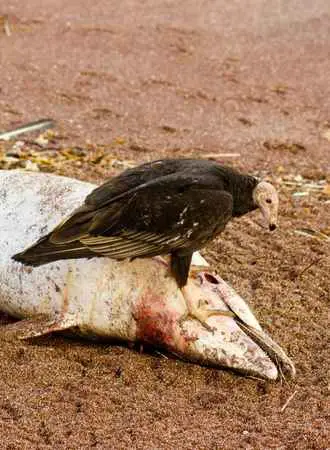
Vultures: The Ultimate Scavengers
Vultures are synonymous with feasting on the remains of dead animals, be it from natural causes or from large cat hunts. These birds have a diverse palate, and their menu includes rodents, reptiles, carrion, fruit, garbage, and much more. Their sharp talons and bills and incredible sense of smell make vultures efficient scavengers.
Kites: Eagles of the Scavenger World
Kites share many similarities with vultures and are also scavengers rather than hunters. They are known for their powerful eyesight and can spot a dead animal from far away. They’ll pick up the animal in their talons and take it back to their nest to feed. Kites have been known to scavenge together, especially when food is scarce.
The Majestic Condor: King of the Sky Carcass Feeders
The Condor is a large bird of prey that is native to the Americas and is known for its massive wingspan and powerful flight. With their distinctive black plumage and bare heads, Condors are easily recognizable and can often be found in remote, mountainous regions. Condors primarily eat carrion and are excellent scavengers, capable of spotting a dead animal from great distances.
Condors are an important part of the ecosystem, helping to clean up dead animals and preventing the spread of disease. However, due to habitat loss and hunting, their populations have declined significantly in recent years. Conservation efforts are underway to protect and preserve these magnificent birds, including the release of captive-bred individuals back into the wild. Whether soaring over the mountains or perched atop a cliff, Condors are truly awe-inspiring birds that deserve our protection and respect.
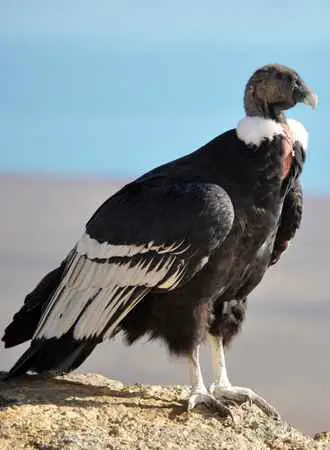
Skua Gulls – The Arctic Hunters
Found in the Arctic and Antarctic, Skua gulls are often mistaken for seagulls, but they’re not related. These birds actively hunt their prey instead of relying on carrion. They use their sharp, hooked bill to pick fish out of the water and will even attack penguins and other seabirds to steal their food.
A Master of the Carrion Scene: The Black Vulture
Black vultures are a familiar sight to many people, especially those living in rural areas. These birds have a keen sense of smell that allows them to find carrion from great distances. They are often seen circling high in the sky, using their keen eyesight to locate food.
Once they’ve found a meal, they dive down to feed, using their powerful beaks to rip open the tough hide of an animal. Black vultures play a crucial role in the ecosystem by cleaning up dead animals, which helps prevent the spread of disease.
They are tireless scavengers and can often be seen feeding alongside other birds such as turkey vultures and buzzards. These birds may not be the prettiest or the most graceful, but they are certainly an important part of the ecosystem, serving as one of nature’s clean-up crews.
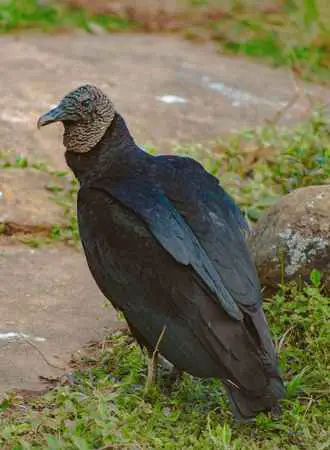
Carrion Connoisseur: The Egyptian Vulture’s Diverse Diet
With its unmistakable yellow face and black-tipped bill, the Egyptian vulture is a recognizable sight in the Middle East, Southern Europe, and parts of Africa. This scavenger bird is known for its love of carrion and is often seen feasting on rubbish dumps and carcasses. But the Egyptian vulture is not just a one-trick pony when it comes to food.
This bird is also an opportunist and will eat any small birds, mammals, or reptiles that it can catch. In fact, the Egyptian vulture is known for its resourcefulness and is even reported to use tools, such as rocks or twigs, to access its meals. So, if you happen to spot this unique bird, don’t be surprised if it’s dining on more than just carrion.
Small but Mighty: The Hooded Vulture of Central Africa
Discover the fascinating world of the hooded vulture, a bird that can be easily identified by its brown plumage and fluffy white head. This species can be found in open country, forest edges, and towns, and is known for its unique feeding habits that include mussels, lobsters, mollusks, and dead fish.
Despite its small size, the hooded vulture faces competition from larger, more aggressive vultures, leading to a reduction in their population.
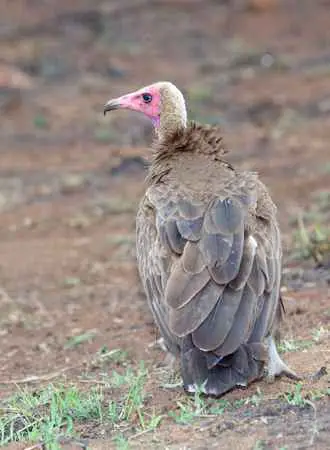
African Fish Eagle
The African Fish Eagle is a large bird of prey that is recognizable by its striking appearance, with a white head and tail, dark brown body, and a large, hooked beak. They are typically found near large bodies of water, such as lakes, rivers, and swamps as African fish eagles hunt alone.
While the African Fish Eagle is primarily a fish-eater, they are also known to eat carrion when the opportunity presents itself. This species is opportunistic and will eat any small mammals, reptiles, or birds that they can catch. Their large size and powerful talons make them formidable hunters, and they are considered to be one of the top predators in their range.
Crested Caracaras
The crested caracara is a large bird of prey with a distinctive crest of feathers on their head from the central and south America region. They have a reddish-brown plumage, a black mask-like marking on their face, and a large, hooked beak. These birds are found in open habitats like grasslands, savannas, and deserts.
While the crested caracara is known for its scavenging habits, these birds primarily eat carrion and other dead animals, they are also opportunistic hunters. They are known to hunt live prey like small mammals, reptiles, and birds, and will also steal food from other animals. In addition, they have been observed using tools such as sticks to extract food from crevices or cracks in rocks.
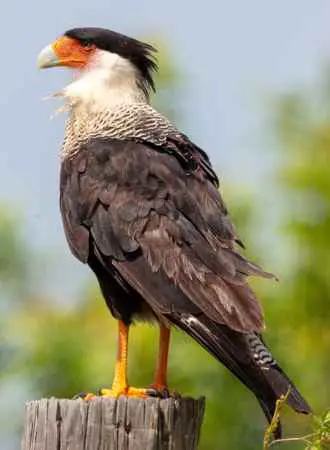
Soaring High: Meet the Griffon Vulture
The Griffon Vulture is a large bird of prey with a wingspan of nearly 6 feet and a distinctive white head with a bald, pinkish face. This species can be found across a broad range of habitats in Europe and Africa, including forests, grasslands, and deserts.
With its keen eyesight and powerful beak, Griffon Vultures are expert scavengers that feed almost exclusively on carrion. These carrion birds are often seen circling high in the sky, searching for their next meal. Once they spot a potential source of food, they swoop down and use their sharp beak to tear apart the flesh of dead animals.
The Griffon Vulture plays an important role in maintaining the balance of ecosystems by consuming decaying animal matter and helping to keep the landscape free of rotting flesh. Despite their reputation as scavengers, these magnificent birds are an essential part of the food chain and are truly a wonder to behold in flight.
Bald Eagles: King of the Skies
The Bald Eagle is a majestic bird of prey, with a distinctive white head, a sharp yellow beak, and a brown body. They are large birds, with a wingspan of up to 7 feet, making them one of the largest birds of prey in North America. They are found near large bodies of water, where they hunt for fish and other aquatic creatures.
However, the Bald Eagle is not just a hunter – they also have a scavenger’s side to their diet. Bald eagles eat carrion, such as dead fish, as well as small mammals, reptiles, and other birds. In the wild, they can often be seen perched on tree limbs, waiting for an opportunity to swoop down and grab a meal. With their keen eyesight, powerful wings, and fierce talons, the Bald Eagle is truly a force to be reckoned with, both in the air and on the ground.

Osprey: The Majestic Fisherman of the Skies
The Osprey is a large bird of prey, known for its distinctive appearance with a white head and tail, dark brown back and wings, and yellow eyes. They can be found near coastlines, lakes, rivers, and wetlands, where they hunt for fish.
Despite its specialized diet, the Osprey is not considered a vulture because it primarily feeds on live fish that it catches in its talons. However, it will also scavenge on dead fish or eating rotting carcasses when the opportunity arises and even scavenging dead bait fish from fishermen. With its keen eyesight and powerful diving skills, the Osprey is a magnificent hunter, making it a fascinating bird to watch.
African Fish Eagles
The African Fish Eagle is a large bird of prey, recognized by its distinctive white head, chocolate brown body, and bright yellow bill and feet. With a wingspan of over 6 feet, the African Fish Eagle is a formidable sight in flight and is easily recognizable from a distance.
As their name suggests, this bird primarily feeds on fish, but will also scavenge for carrion if necessary. They have been known to steal fish from other birds and animals and have also been observed raiding osprey nests for food and eating decaying flesh.
The African Fish Eagle is also a strong swimmer and has been known to dive into the water to catch fish. Their keen eyesight and powerful talons make them effective hunters, and they are considered a symbol of power and freedom in many African cultures.
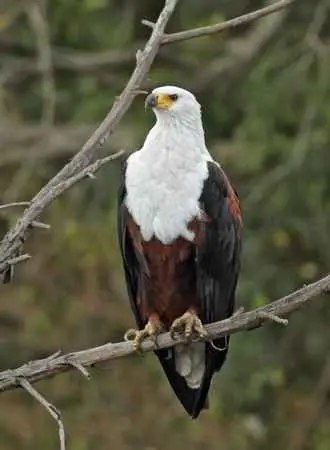
Turkey Vulture – The Carrion Connoisseur of North America
The Turkey Vulture, also known as the turkey buzzard, is a large bird of prey found throughout North and South America. This scavenger is easily recognizable by its bald head and large, broad wings that allow it to soar through the sky with ease. With keen senses and a keen eye, the Turkey Vulture can detect the scent of carrion from miles away, making it one of the most efficient scavengers in the animal kingdom.
With a dark brown body and a wingspan that can reach up to six feet, the Turkey Vulture is a formidable sight in the sky. They eat dead animals and roadkill and can often been seen to eat dog carcasses.
Hooded Vultures
The Hooded Vulture, with its unique combination of brown plumage and pink, fluffy head, is a common sight in the open country, forest edges, and towns of Central Africa. These small vultures have a narrow, curved beak, blue eye-rings, and a rounded tail, which, combined with their silvery flight feathers, make them easily recognizable in flight.
Despite their small size, Hooded Vultures are opportunistic feeders and will consume a variety of food sources, including mussels, lobsters, mollusks, dead fish, grasshoppers, grubs, decaying carcass and locusts. However, they often find themselves displaced from their food sources by larger and more aggressive vultures, leading to a decline in their numbers.
American Crow
The American Crow is a common bird found throughout North America. They are known for their intelligence and ability to use tools, making them one of the most adaptable birds in the wild.
While their diet primarily consists of insects, fruits, and seeds, American Crows are also known to feed on carrion, including roadkill and dead animals. They are attracted to dead animals and will often scavenge in groups, called a “mourning” or “death” procession.
Despite their reputation as scavengers, American Crows also play an important role in controlling the populations of other pests, such as grubs and caterpillars, by consuming them.
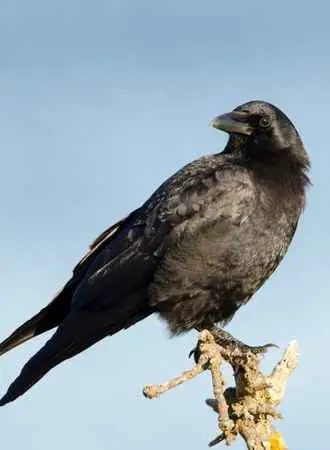
Common Raven (Corvus corax)
The Common Raven is a large, all-black bird that is well known for its intelligence and problem-solving abilities. They have a strong, curved beak, and powerful wingspan, which can reach up to 4 feet, that enable them to soar through the air with ease.
Common Ravens are omnivores, which means they eat a wide variety of foods including carrion, insects, small mammals, fruits, and more. They are also known to scavenge on animal carcasses and are often seen near roadkill or other sources of dead animals. They will feed on smaller birds, as well as eggs and young of other birds, when given the opportunity.
Despite their reputation as birds that eat dead animals, Common Ravens are scavenger birds that are highly adaptable birds that are able to find food in a variety of environments.

